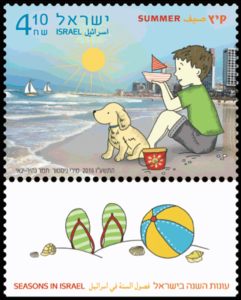 Our calendar consists of twelve months – the amount of time it takes the Earth to complete one full cycle around the Sun.
Our calendar consists of twelve months – the amount of time it takes the Earth to complete one full cycle around the Sun.
The 365 days of the year are divided into four different seasons, each of which complements another: winter and summer, spring and autumn. Each season is characterized by its own typical weather, changes in the animals and plants and by its designated songs. Every season creates a certain type of atmosphere. In Israel the transitional seasons ñ autumn and spring ñ are short and often bring surprising weather changes.
Summer
Summer is the driest and hottest season of the year. The days are longer. The green and colorful landscapes give way to grey hues and dryness after the first heat waves.
“Oh my country, my homeland, bold rocky mountain”, wrote poet Shaul Tchernichovsky, who came from forested and water abundant Ukraine to the dry, brown-gold summer of Eretz Israel. But in the fields crops ripen and summer fruit appears in orchards, a celebration of flavors and colors. Naomi Shemer describes the fruit stalls in the “Market Song”: “There are mountains of watermelons next to hills of apples”.
Summer is children’s favorite season. They are finally on vacation, there is time for hiking, trips and having fun. Lots of free time. Summer means going to the beach, taking a dip in the cool blue water and building castles in the sand.
From the theme song for the children’s television program Carousel, which described the seasons of the year:
“So come whirl round on the carousel
Down and up and all around,
So come whirl round on the carousel
In summer, winter, autumn and spring”
—Leah Naor
Author, translator and poet
* All songs and poems have been loosely translated from the original Hebrew.
The stamp shows Tel Aviv beach.
Photograph © Shutterstock.
Technical Details:
Issue: June 21, 2016
Stamp Size (mm): H 30 x W 40
Plate: 1024
Stamps per Sheet: 15
Tabs per Sheet: 5
Method of printing: Offset
Security mark: Microtext
Printer: Cartor Security Printing, France.



